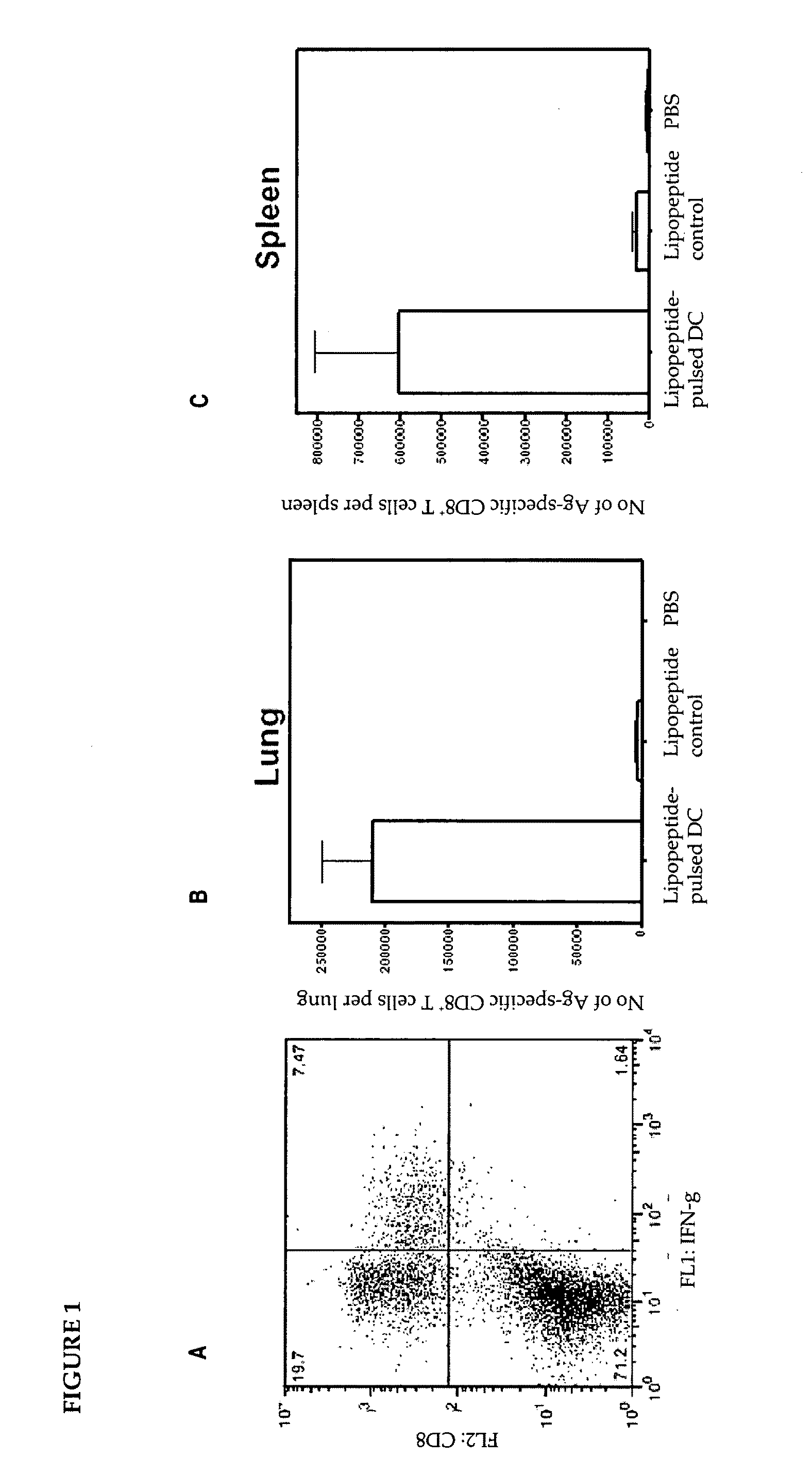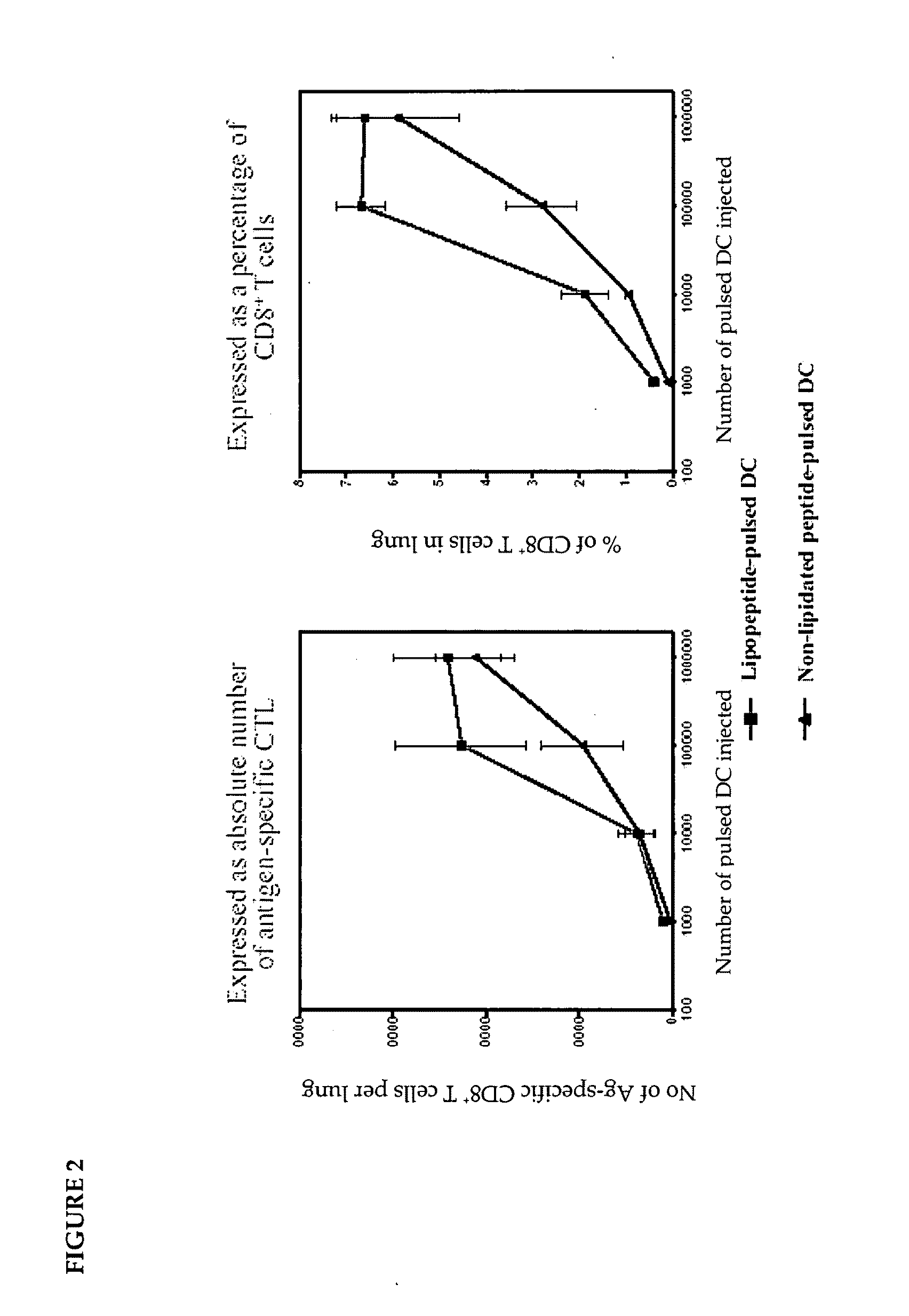Immunotherapy of virus infection
a virus infection and immunotherapy technology, applied in the field of immunotherapy of virus infection, can solve the problems of inability to discriminate between acute and persistent infection, inability to detect anti-hcv antibodies, and inability to cure, etc., to achieve adequate priming and expansion of nave cd8sup>+/sup> t cells, and achieve the effect of improving the survival rate of hcv infection
- Summary
- Abstract
- Description
- Claims
- Application Information
AI Technical Summary
Problems solved by technology
Method used
Image
Examples
example 1
Materials and Methods
Mice
[0115]BALB / c mice, 6-8 weeks old or C57BL6 mice were obtained from the breeding facility at the University of Melbourne. The mice were individually tagged by ear marking to permit unequivocal identification throughout the duration of the experiment.
Dendritic Cell Culture
[0116]Dendritic cells (DC) were cultured in medium based on complete IMDM. This consisted of Iscove's Modified Dulbecco's Medium (IMDM) containing 25 mM HEPES and without alpha-thioglycerol or L-glutamine (JRH Bioscience, Lenexa, USA), supplemented with 10% (v / v) heat inactivated (56° C., 30 min) foetal calf serum (CSL Ltd., Parkville, Victoria, Australia), gentamicin (24 μg / mL), glutamine (2 mM), sodium pyruvate (2 mM), penicillin (100 IU / mL), streptomycin (180 μg / mL) and 2-mercaptoethanol (0.1 mM). For DC generation complete IMDM was further supplemented with 30% supernatant from cultured NIH / 3T3 cells and 5% GM-CSF in the form of a supernatant from Ag8653 cells transfected with the GM-CSF ...
example 2
Adoptive Transfer of Dendritic Cells
[0133]The expression of toll-like receptor 2 (TLR2) on an immature dendritic cell line (D1) was examined. D1 cells were first stained with a rat anti-mouse TLR2 monoclonal antibody and any bound antibody was then detected by FITC-conjugated anti-rat immunoglobulin. The cells were then analyzed by flow cytometry (data not shown).
[0134]A low level of surface expression of TLR2 was detected on D1 cells, by comparing the staining profile with those obtained by incubating D1 cells with an irrelevant or in the absence of a primary antibody. The surface expression of TLR2 on D1 cells might explain how lipopeptides target DC, which leads to their maturation, resulting in up-regulation of its surface expression of MHC molecules and co-stimulatory molecules and the release of cytokines, such as IL-12.
[0135]Although these observations might provide an explanation for the enhanced immunogenicity of the lipopeptide in vivo as compared to non-lipidated peptide,...
example 3
Toxicological Analysis of HCV Peptide-Pulsed Murine Dendritic Cells after Autologous Transfusion to Mice
[0144]Three groups of 20 C57BL6 mice were used in the study:
[0145]Group 1—no treatment; Group 2—injected with 2×106 syngeneic murine DC, by the id and iv routes (50% each) in a vaccination schedule of T=0, T=14 days and T=28 days. Group 3-injected in a similar manner with lipopeptide-pulsed murine DC with dose multiples of DC in a 3 dose schedule as shown below.
TABLE 1Adoptive transfer schedule for murine DC.Group 1Group 2Group 3InterventionNo treatmentSyngeneic murineLipopeptide-pulsedDCsyngeneic murine DCNo. of mice202020Dose scheduleDay 0—3.5 × 105 IV3.5 × 105 IV3.5 × 105 ID3.5 × 105 IDDay 14—3.5 × 105 IV3.5 × 105 IV3.5 × 105 ID3.5 × 105 IDDay 28—3.5 × 105 IV3.5 × 105 IV3.5 × 105 ID3.5 × 105 IDDay 35SacrificeSacrifice miceSacrifice micemiceIV = intravenous;ID = intradermal
[0146]The lipopeptides used were the common Th epitope; KLIPNASLIENCTKAEL (SEQ ID No:8), derived from the f...
PUM
| Property | Measurement | Unit |
|---|---|---|
| antigen processing capacity | aaaaa | aaaaa |
| electron microscopy | aaaaa | aaaaa |
| frequency | aaaaa | aaaaa |
Abstract
Description
Claims
Application Information
 Login to View More
Login to View More - R&D
- Intellectual Property
- Life Sciences
- Materials
- Tech Scout
- Unparalleled Data Quality
- Higher Quality Content
- 60% Fewer Hallucinations
Browse by: Latest US Patents, China's latest patents, Technical Efficacy Thesaurus, Application Domain, Technology Topic, Popular Technical Reports.
© 2025 PatSnap. All rights reserved.Legal|Privacy policy|Modern Slavery Act Transparency Statement|Sitemap|About US| Contact US: help@patsnap.com



